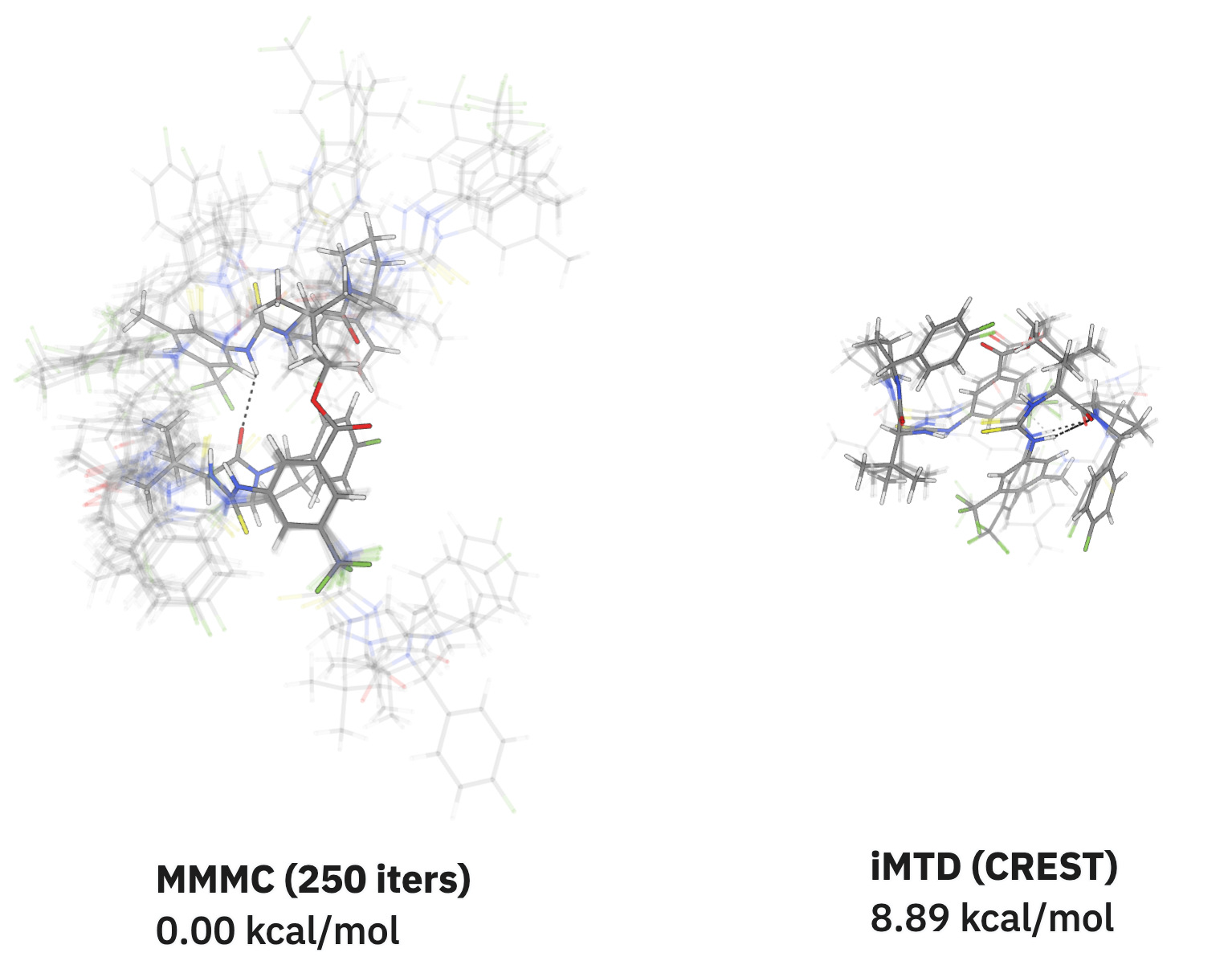Predicting Spin States of Metal-Organic Complexes
by Jonathon Vandezande · Oct 10, 2024
Molecules can exist in a variety of spin states (the arrangement of the spins of the electrons within a molecule). Most organic molecules are closed-shell species, where all up [↑] and down [↓] spins of electrons are paired [↑↓] in orbitals. Most organic molecules that are radicals (having unpaired electrons) only have a single unpaired electron (doublet ground state), and thus no ambiguity in the correct spin state. However, metal-containing molecules often have many partially filled orbitals that are close in energy, and many different orbital occupations are possible, making the preferred spin-state non-obvious. Determining the lowest energy spin state of a molecule or complex is crucial for further understanding its geometry and properties. Open-shell species can have radically different structures than their closed-shell counterparts, and the number of unpaired electrons has significant effects on the reactivity and spectra of these species.
Field Effects in Metal-Ligand Species
The preferred spin state of a metal-ligand species is dependent on many factors, including the σ- and π-donating/accepting nature of its ligands, the oxidation state of the metal center, and the local geometry. For simple systems, ligand field theory and Tanabe-Sugano diagrams can be used to help predict the spin state. Electrons will only pair up if the energy gap between d-orbitals is high enough, allowing us to predict the spin state based on how the field of the ligands affects the orbital energies. "Strong-field ligands" like carbonyl or cyanide produce a large split in the d-orbital energies of the metal, leading to paired electrons and low-spin complexes, while "weak-field ligands" like chloride produce a small split, leading to high-spin complexes.
Figure 1: Orbital energy diagrams with electron pairing for high- and low-spin octahedral d5 species. If the energy gap between the orbitals is small, the electrons will stay unpaired (high spin) due to the exchange interaction. If the gap becomes large enough, the electrons will tend to pair up (low spin).
Octahedral Species
If the ligand strength, coordination geometry, and oxidation state of the metal are known, Tanabe-Sugano diagrams can be used to predict the spin-state, as in figure 2 for octahedral d5 species.
Figure 2: Octahedral d5 Tanabe–Sugano diagram. Weak field ligands (left) lead to a 6A1 ground spin state, while strong field ligands (right) lead to a 2T2 spin state (image from TungstenEinsteinium CC BY-SA 4.0).
We can also predict the spin states using density-functional theory. The below calculations show octahedral d5 species with weak-field (Cl–) and strong-field (CO) ligands. The species with weak field ligands (Cl–) prefers the high-spin state (6A1), as the splitting between orbitals is small, while the species with strong-field ligands (CO) prefers the high-spin state (2T2).
Tetrahedral Species
Weak-field and strong-field ligands have the same effect for the tetrahedral species, but since tetrahedral splittings (ΔT) are significantly weaker than for octahedral splittings (ΔO), most species prefer the high-spin state. In this case, moving from carbonyl to chloride lowers the preference for the high-spin state by 30 kcal/mol, but the high-spin state remains favored.
Figure 3: Orbital splittings for tetrahedral and octahedral species. The orbital energy splittings for tetrahedral species are only 4/9x as strong as those for octahedral species.
Additionally, the increased space present in tetrahedral complexes allows for significant rearrangement of the ligands based on the spin state to non-tetrahedral geometries. This is common upon reduction/oxidation of tetrahedral metal centers or photoexcitation, leading to further shifting of the energy gaps between the spin states, along with significant Stokes shifts in their UV-Vis spectra.
Spin States in Organometallic Species
Spin-state prediction is also useful for organometallic species. Here, we'll demonstrate this for iron porphyrin complexes, which are used as catalysts for many different reactions due to their high-spin ground states and easily modified scaffold. Fe(II)-porphyrin on its own has a square planar geometry due to the rigid porphyrin framework, with a strong preference for the triplet state:
In hemoproteins, there are typically one or two ligands attached at the axial sites, often a histidine (represented by an imidazole below). Binding at the axial site converts this to a square pyramidal geometry, lowering the relative energy of the dx2–y2 orbital and increasing the energy of the dz2 orbital. The penalty for pairing electrons in orbitals becomes nearly equivalent to the orbital energy difference, leading to a near degeneracy in spin-state energies between the singlet, triplet, and quintet states.
When O2 binds, converting it to a quasi-octahedral geometry, the triplet state again becomes strongly preferred, but this time with the unpaired electrons being on the O2.
Understanding the spin-state of these species is important for further modeling. Due to the open-shell nature of the ground spin-state, they cannot be modeled reliably with traditional force fields. Additionally, these unpaired electrons will affect the EPR and other spectral properties, and predicting them a priori will help interpretation of the spectra. Additionally, these species often bind protons, and changing the spin state has a drastic effect on the acidity.
Oxidizing the iron to +3 leads to a completely new spin-state manifold, this time favoring the quartet state. A similar analysis can then be performed for modifications of this +3 oxidation state as was done for the +2 state.
Case Study: Physically Separable Co(II) Spin States
Spin-state prediction can also be useful when synthesizing exotic molecules. A recent study by Wheaton, et al. synthesized "cobalt(II) spin-state isomers that can be physically separated." Spin-state predictions with Rowan show that the energetics of both the doublet and quartet are similar in energy, as would need to be for this to be easily realized.
There are significant geometry changes between the two spin states. Increasing spin leads to a shrinking of both the Mo–Co and Co–Br bond distances, yielding a concomitant twisting of the ligands to account for this shortened distance. This in turn places the ligands closer together, likely displacing some of the solvent and affecting the intermolecular interactions. The chlorine-containing analogue does not show as dramatic a rearrangement upon change of spin state, consistent with the observation that the chloride-containing spin states cannot be chemically separated. While a complete computational analysis of this species would require the consideration of crystal packing effects, experimental X-ray spectroscopy results show similar trends.
Rowan's spin-state-prediction workflow makes it fast and simple to run research-quality calculations and accurately predict the spin state of your metal complexes. To get started, you can sign up for a free account.
Further Reading
- Tanabe-Sugano diagrams
- Spectrochemical series
- Crystal field theory
- Ligand field theory
- Geometry prediction with r2SCAN-3c in metal porphyrins, DOI: 10.1002/jcc.26870









